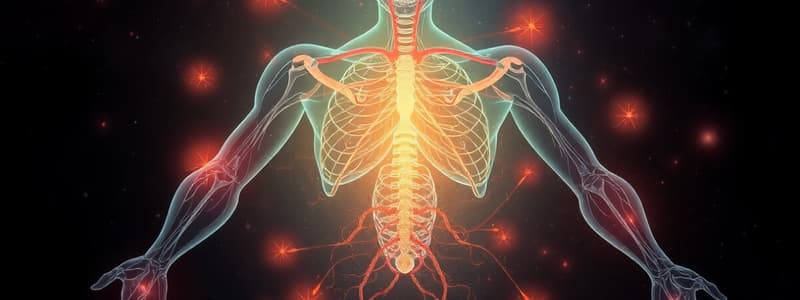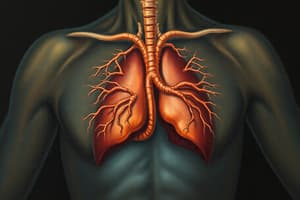Podcast
Questions and Answers
What is the primary function of Sertoli cells in the testes?
What is the primary function of Sertoli cells in the testes?
- Regulating hormone release
- Producing testosterone
- Supporting sperm production (correct)
- Storing mature ova
Which hormone is primarily produced by Leydig cells in the testes?
Which hormone is primarily produced by Leydig cells in the testes?
- Progesterone
- Estradiol
- Oxytocin
- Testosterone (correct)
How do stress hormones influence behavior in animals?
How do stress hormones influence behavior in animals?
- They have no effect on behavior.
- They mediate behavioral responses to stress. (correct)
- They solely regulate hormone production.
- They only influence physical responses.
Oxytocin is often referred to as which of the following?
Oxytocin is often referred to as which of the following?
What significant impact does kisspeptin have on the reproductive system?
What significant impact does kisspeptin have on the reproductive system?
Why is the effect of pheromones in humans considered limited?
Why is the effect of pheromones in humans considered limited?
What behavior changes have been associated with oxytocin in animal studies?
What behavior changes have been associated with oxytocin in animal studies?
What role does the cortex play in human behavior compared to hormonal influences?
What role does the cortex play in human behavior compared to hormonal influences?
What is a primary function of the adrenal glands?
What is a primary function of the adrenal glands?
Which hormone is primarily secreted by the thyroid gland?
Which hormone is primarily secreted by the thyroid gland?
What is the role of melatonin produced by the pineal gland?
What is the role of melatonin produced by the pineal gland?
Which hormones are primarily produced by the gonads?
Which hormones are primarily produced by the gonads?
How do hormones influence behavior?
How do hormones influence behavior?
Which of the following hormones from the adrenal gland is involved in the body's stress response?
Which of the following hormones from the adrenal gland is involved in the body's stress response?
Which statement is true regarding the functions of the thyroid hormones?
Which statement is true regarding the functions of the thyroid hormones?
Which gland is primarily responsible for the regulation of melatonin?
Which gland is primarily responsible for the regulation of melatonin?
What is the primary function of hormones secreted by the adrenal glands?
What is the primary function of hormones secreted by the adrenal glands?
Which hormone is primarily secreted by the thyroid gland and is crucial for regulating metabolism?
Which hormone is primarily secreted by the thyroid gland and is crucial for regulating metabolism?
What effect does melatonin, secreted by the pineal gland, primarily have on the body?
What effect does melatonin, secreted by the pineal gland, primarily have on the body?
Which of the following hormones is produced in the gonads and is essential for reproductive functions?
Which of the following hormones is produced in the gonads and is essential for reproductive functions?
How do hormones influence behavior according to principles of hormone function?
How do hormones influence behavior according to principles of hormone function?
Which type of hormone receptor is typically found close to the nucleus and elicits slower responses?
Which type of hormone receptor is typically found close to the nucleus and elicits slower responses?
Which of the following describes a characteristic of hormone secretion?
Which of the following describes a characteristic of hormone secretion?
What is an example of a negative feedback mechanism in hormone regulation?
What is an example of a negative feedback mechanism in hormone regulation?
Flashcards are hidden until you start studying
Study Notes
Introduction to Hormones
- Hormones are secreted primarily by glands but also other tissues, released primarily into the bloodstream but also locally, and released primarily by animals but also plants.
- Exocrine glands release substances into ducts that open onto a surface. In contrast, endocrine glands release hormones directly into the bloodstream.
- Different systems for chemical release: neurocrine, endocrine, autocrine, paracrine, pheromone, allomone.
- Hormones have slow-acting, gradual effects that affect behavior changes in intensity and probability rather than polarity.
- Behavior and hormone release are reciprocal, and hormones can have multiple effects.
- Hormone secretion is often pulsatile and rhythmic, and hormones can interact with each other.
- Hormones need receptors to exert their effects, which differ from neurotransmitter function.
The Hypothalamus & Pituitary Gland
- The hypothalamus (HTh) is the junction between the nervous system (NS) and the endocrine system.
- The HTh contains neuroendocrine cells, also known as neurosecretory cells.
- Some hormones also serve as neurotransmitters.
Hormone Types
- Peptide hormones are chains of amino acids.
- Amine hormones are derived from a single amino acid.
- Steroid hormones are derived from cholesterol.
Hormone Receptor Types
- Membrane receptors, such as G protein-coupled receptors (GPCRs), are faster acting.
- Intracellular receptors, which are usually near the nucleus, are slower acting and often act as transcription factors to influence gene expression.
Methods for Studying Hormones and Receptors
- Radioimmunoassay uses radioactive isotopes to measure hormone levels.
- Autoradiography uses radioactive isotopes to visualize hormone receptors.
- Immunohistochemistry/immunocytochemistry uses antibodies to detect hormones and receptors within tissues.
- In situ hybridization uses labeled probes to detect mRNA transcripts for hormones and receptors.
The Pituitary Gland
- The pituitary gland is the other side of the NS/endocrine intersection, connected to the hypothalamus via the infundibulum (pituitary stalk).
- It is composed of the anterior pituitary and posterior pituitary, which release different hormones.
Notable Glands (Gonads)
- The gonads (testes and ovaries) have two compartments: one for sex hormone production and one for gamete production.
- Testes contain Sertoli cells (sperm production) and Leydig cells (androgen production, e.g. testosterone).
- Ovaries produce ova (mature gametes) and steroid hormones (progestins, e.g. progesterone, and estrogens, e.g. estradiol).
Hormones in Behavior: Prairie Vole
- Hormones influence behavior, but with notable limitations in humans.
- Hormones can influence behavior through organizational (developmental) and activational (short-term) effects.
- Oxytocin and vasopressin/ADH are implicated in social behavior, and their receptors are found in the ventral pallidum (VP) of the brain.
- Prairie voles, known for monogamous pair bonds, have different levels of oxytocin and vasopressin receptors compared to promiscuous meadow voles.
The "Love Molecule"
- The promise of oxytocin as a "love molecule" is alluring, but research shows a more complex story.
- Oxytocin can increase in-group bias, but also increase propensity for revenge.
Pheromones
- Pheromones are chemical signals that mediate behavior in non-human animals through the vomeronasal organ (VNO).
- Humans have a rudimentary VNO, and putative human pheromone effects often don't replicate.
Stress Hormones
- Stress hormones mediate behavior in all animals, including humans.
- Stress activates the adrenal gland through the hypothalamic-pituitary-adrenal (HPA) axis and the sympathetic nervous system.
- The HPA axis is a slow response to stress, while the sympathetic nervous system is a fast response.
Studying That Suits You
Use AI to generate personalized quizzes and flashcards to suit your learning preferences.



